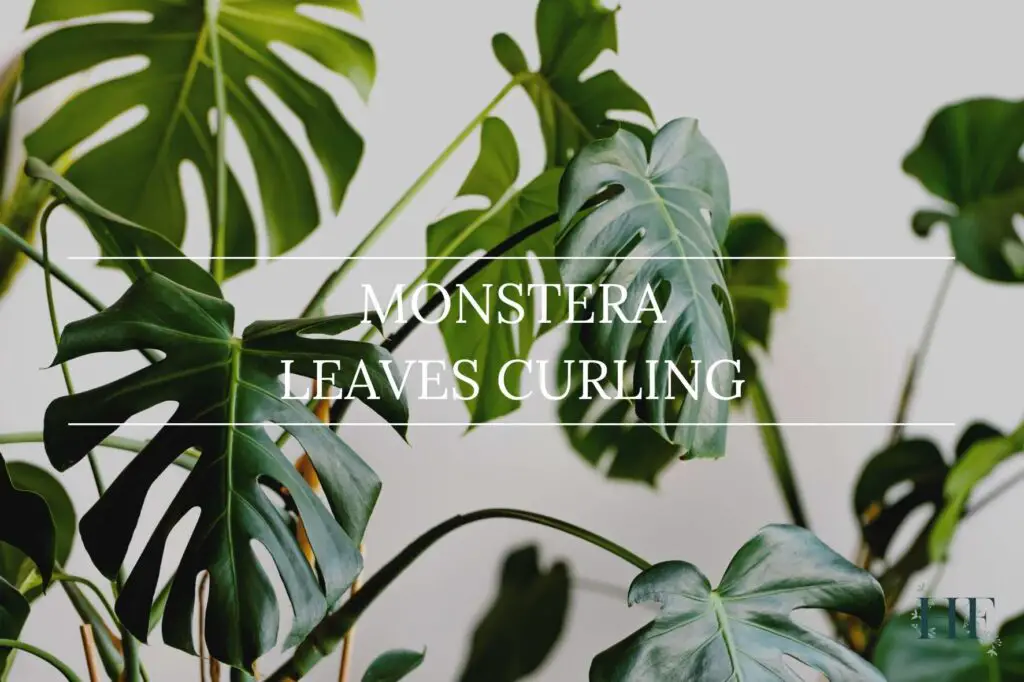Monstera plants tend to show any signs of problems through their leaves. That’s why sometimes you come across yellow leaves, brown leaves, droopy leaves and even curling leaves!
Monstera leaves curling can occur for many different reasons, so you will have to go through a process of elimination in order to determine the base cause.
In this blog post, I will cover the most likely causes of Monstera leaf curl and how to fix the problem so your Monstera’s leaves are beautiful and healthy again!
Why Are My Monstera Leaves Curling?
In general, monstera leaves curl as a way to reduce the amount of exposed surface area and minimize water loss through transpiration. The most likely culprit is thirst or dryness. Although it’s a natural adaptive measure, it shows that your Monstera plant is in distress.
Monstera leaves curling is usually a sign of underwatering or low humidity. Other causes include temperature stress, overfertilisation, being rootbound, pest infestation, overwatering or using chlorinated tap water when watering.
While it’s not life-threatening, your plant is in distress and may even impede the plant’s ability to photosynthesize properly. That’s why it is key to identify the main reason for leaf curling and take action to ensure that your monstera continues to grow healthily.
As a side note, the tight curling of new leaves in a Monstera plant is normal before they unfurl.
Ways Monstera Leaves Curl
Before addressing each possible cause, there are a few different ways a Monstera leaf might curl, and this can give you clues about the key issue.
Monstera Leaves Curling Inward
If your monstera’s leaves are curling inwards or upwards toward the top of the leaf, it could be a sign of a watering issue (either underwatering or overwatering), lack of humidity, or sometimes a pest infestation.
Monstera Leaves Curling Down or Outward
If your monstera’s leaves are curling down or outwards toward the bottom of the leaf, it’s for many of the same reasons. Although this is often more suggestive of temperature stress or underwatering (especially if the leaf is lacking turgor pressure). This might be the case if the leaves are thin, limp, or drooping.
Monstera Leaves Crinkling
Crinkled, brittle leaves are often a sign of underwatering or low humidity, especially if it’s accompanied by dry or browning edges.
Causes of Monstera Leaves Curling
Here are the most common reasons for a Monstera’s leaves to curl:
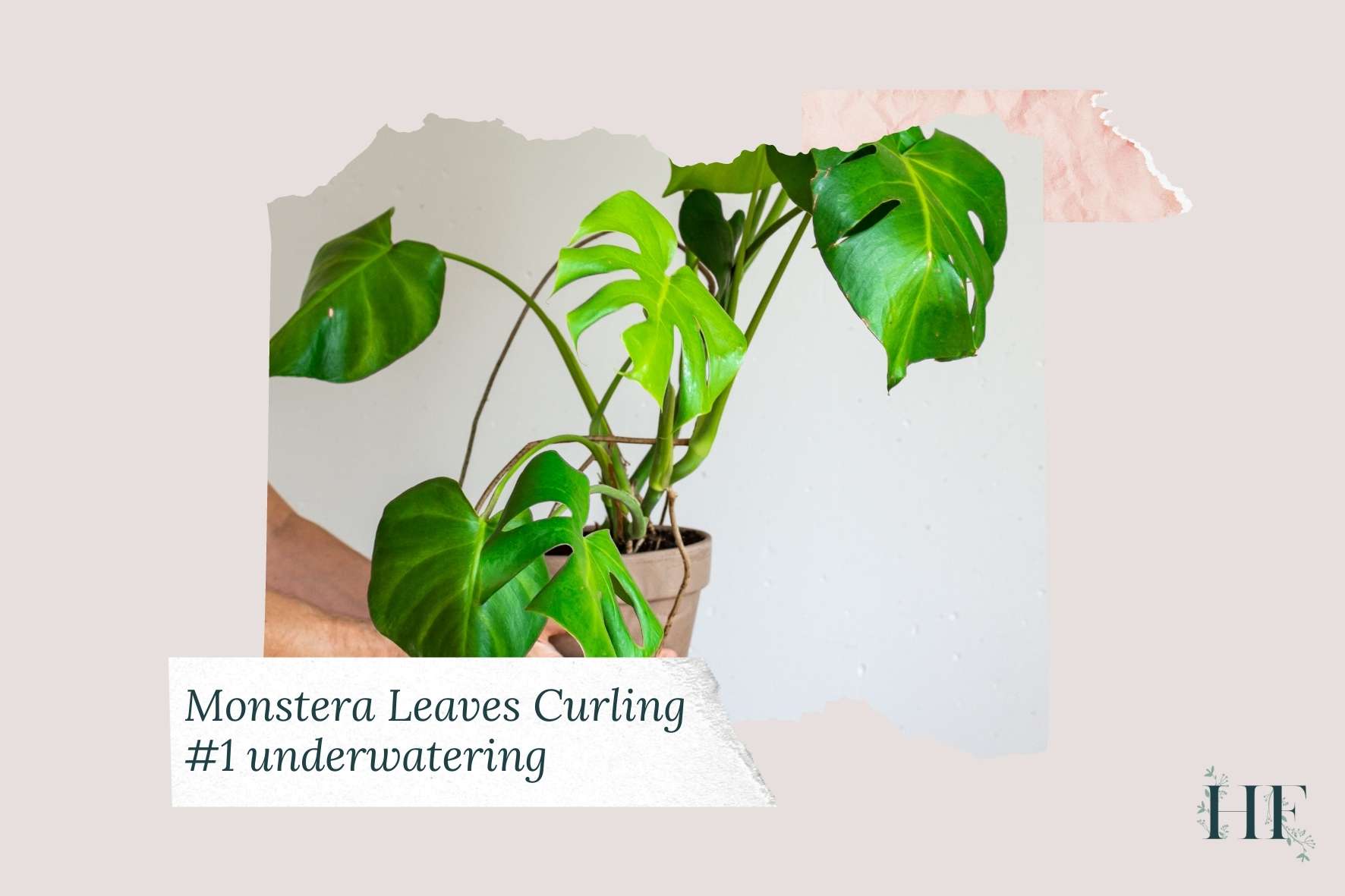
1) Underwatering
Lack of water is the most common cause of curling leaves in Monstera plants.
When your Monstera is underwatered, it activates its natural ability to prevent water loss. Monstera leaves curl to reduce the surface area to avoid releasing too much water moisture into the air by transpiration.
How to Check If Underwatering Is The Cause
- First, check the moisture levels in the soil using a moisture meter (this is the one I use and recommend). If the soil is dry more than a few inches down or reads dry (1-2) on your moisture meter, your Monstera plant needs water.
- Then, check for other underwatering signs such as drooping, crisping (dry brown spots or patches on their leaves), or yellowing or browning leaves.
How to Fix Underwatering
If your Monstera leaves are curling due to underwatering, you should water your plant thoroughly and let the excess water drain freely from the drainage holes in the bottom of the pot before placing it back in its cachepot.
For more, read A Guide to Monstera Water Needs (How Often and When).
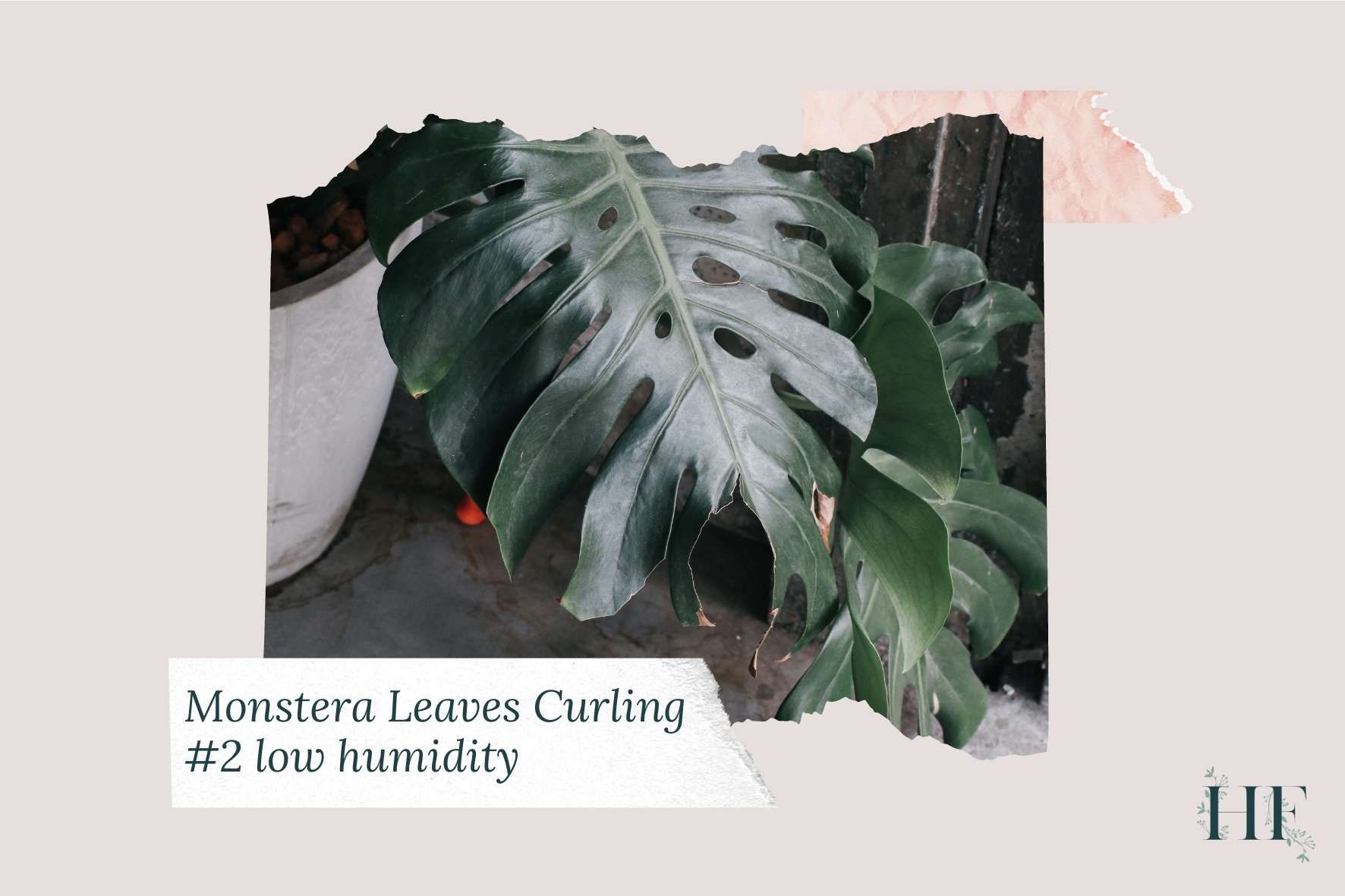
2) Low Humidity
The next most common cause of curling leaves in Monstera plants is dryness (a.k.a., low humidity).
When your Monstera lacks humidity, its leaves curl at the tips and become crispy. If the environment is very dry and the humidity is low, the Monstera leaves will lose more water than normal dry out. As a result, they will start to curl and dry out.
How to Check If Low Humidity Is the Cause
- Check for other signs of low humidity: dry air in the room, yellowing leaves, or wilting and drooping leaves.
- Since it’s very easy to mistake low humidity for underwatering (due to the signs being very similar), to diagnose the problem correctly, you will need a hygrometer. This will allow you to determine the humidity levels of the room.
How to Fix Low Humidity
To prevent curling leaves, your Monstera should be placed in a room with humidity levels between 40% to 60% (ideally 60% or above, but they do well with medium levels of humidity too).
If the humidity level in your room is 40% or below, you can increase the humidity by using a humidifier, by far the best solution for humidifying an entire room. Alternatively, you can use a pebble tray and group your Monstera with other houseplants.
Also, you want to keep your plant away from a radiator, which causes the air to dry.
For more, read Monstera Humidity & Temperature Needs – 7 Tips to Get It Right.
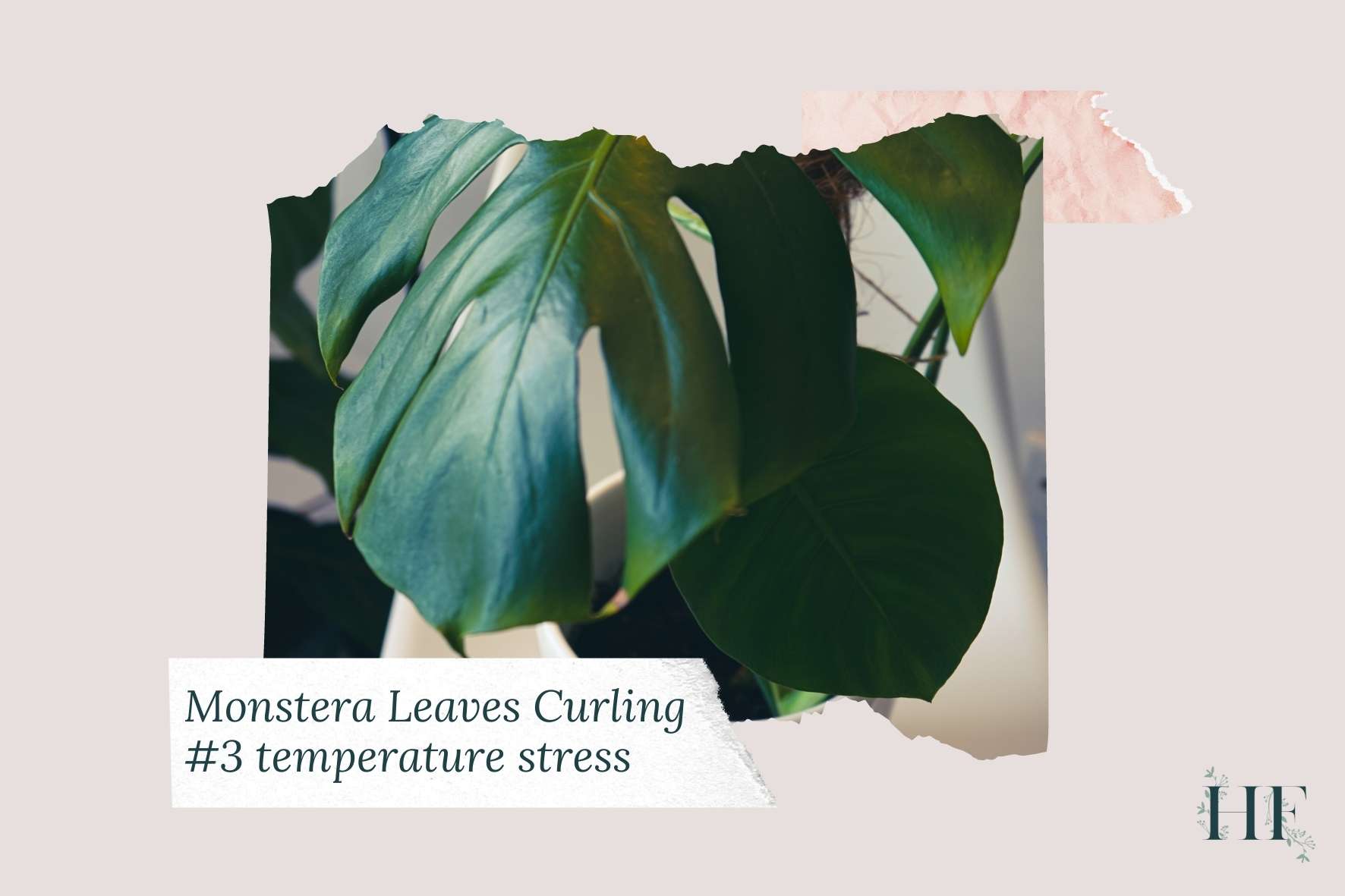
3) Temperature Stress
Monstera leaves are also likely to be affected by sudden temperature changes. Monstera leaves tend to drop when going from warm to cold temperatures very quickly (for instance, a cold draft in winter).
However, their leaves tend to curl when going from a stable medium temperature to a high one (for example, from a cool air-conditioned room to a warm room in the summer).
When the temperature increases abruptly, your Monstera leaves will curl because it’s transpiring at higher rates due to increased temperatures. Heat causes rapid water loss from the leaves. For instance, at 30ºC, a leaf may release water moisture three times as fast as it would at 20°C (source).
How to Check If Temperature Stress Is the Cause
- Check your room temperature. The ideal temperature range for an indoor Monstera is between 20 to 30°C (68–86 °F).
- High temperatures and direct sunlight can lead to sunburn. So, you can look for signs such as brown leaf tips that curl inward.
How to Fix Temperature Stress
If your Monstera leaves are curling, assess both temperature and humidity levels. You can use a hygrometer (which is what I use). This will allow you to adjust your Monstera’s growing conditions accordingly.
Also, assess your Monsteras’ location:
- Is it next to a west-facing window where it gets strong afternoon sun?
- Has the room temperature increased considerably (i.e., a heatwave in the middle of summer)?
- Is it next to the radiator?
When that’s the case, it would be best to relocate your Monstera where the temperature will be more stable and away from direct sunlight.
An ideal location for your Monstera will be in bright indirect sunlight from east or south-facing windows.
For more, read Monstera Humidity & Temperature Needs – 7 Tips to Get It Right and Monstera Light Requirements – How Much Does It Need?
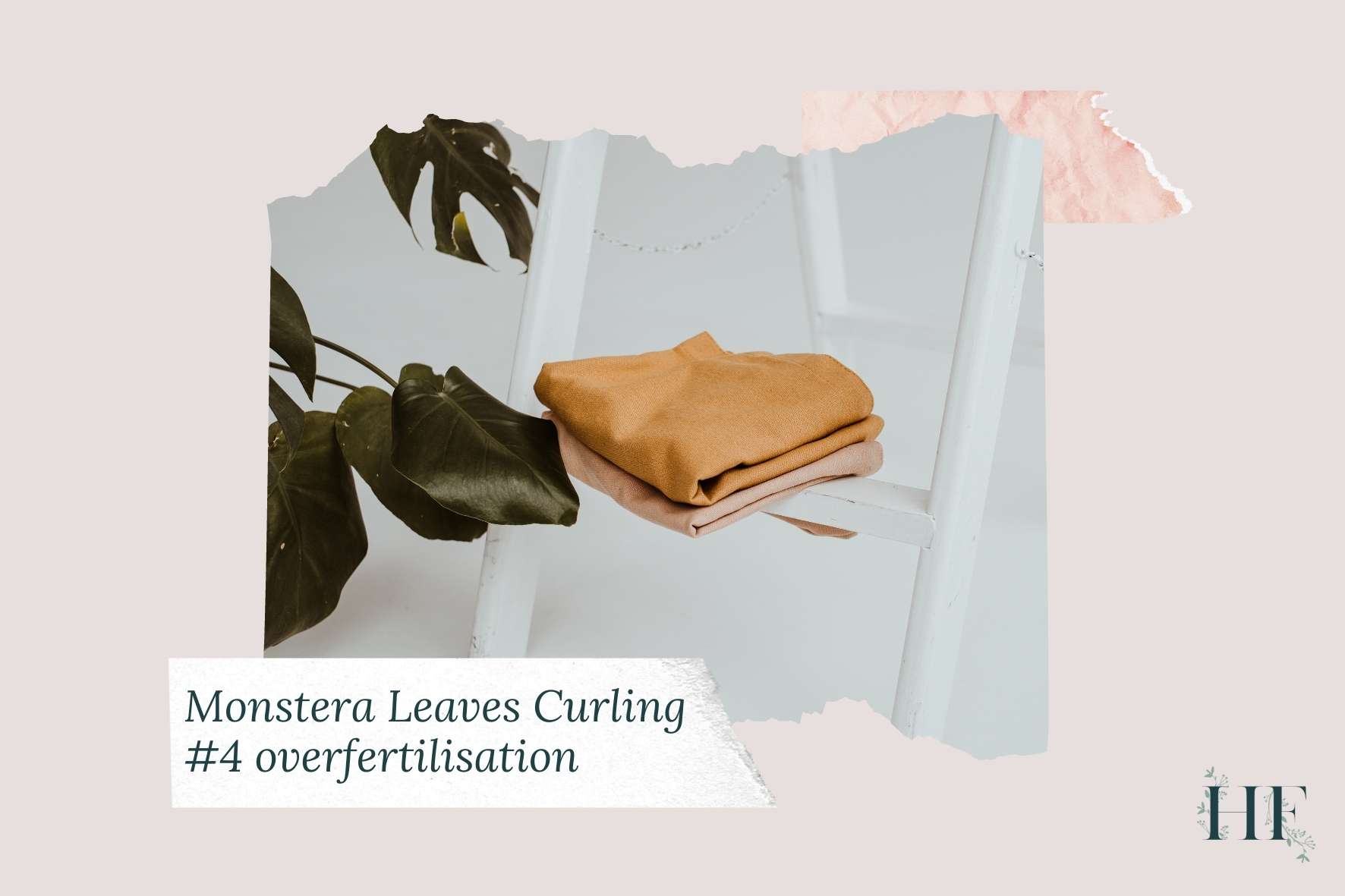
4) Overfertilisation
Although when your Monstera is overfertilised, its leaves wilt or drop. If the problem is accompanied by a lack of water (underwatering) your Monstera leaves can curl in an attempt to lower the transpiration rate.
How to Check If Overfertilisation Is the Cause
- Look for overfertilising signs such as a white crust on top of the soil, or leaves turning yellow and brown on the edges.
- Then, check the moisture levels in the soil. Dry soil is a sign that your Monstera also has an underwatering problem.
- Finally, you can inspect the roots. If the roots are burned and damaged, then it is most likely due to overfertilisation.
How to Fix Overfertilisation
If you find a white crust and the soil is also dry, you can flush the excess fertiliser out by running water through the plant’s soil until it drains from the pot’s bottom drainage holes.
Afterwards, just make sure that your Monstera plant dries thoroughly before the next watering to avoid overwatering. Also, you may want to wait a little longer than usual before fertilising your Monstera again.
But, if you spotted any burned or damaged roots, you can trim them and then repot your Monstera into fresh well-draining soil and pot. It’s best not to reuse the old pot as the build-up salts are difficult to remove.
For more, read A Guide to Monstera Nutrients (Why, When and How to Fertilise).
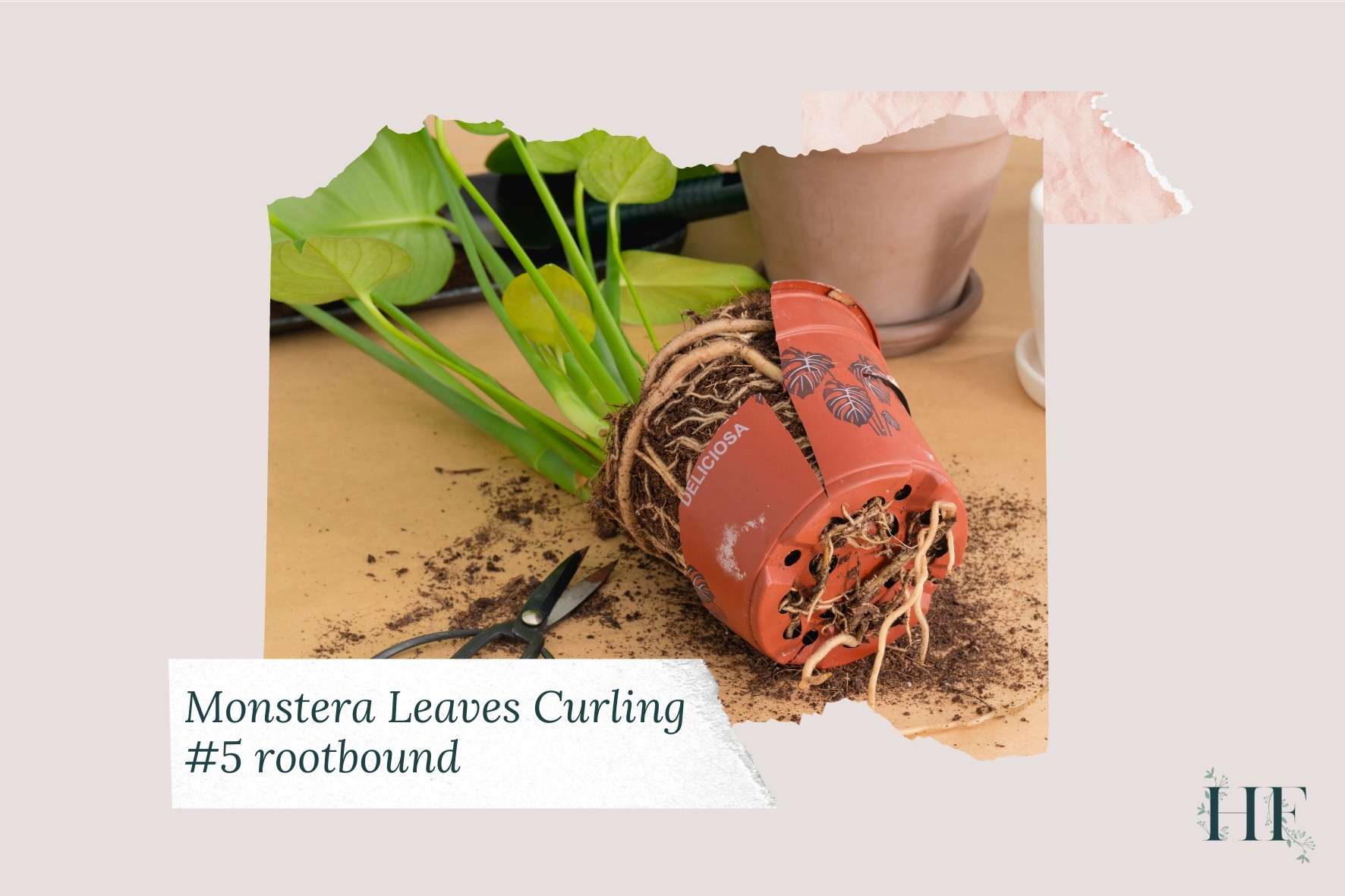
5) Rootbound
If you are struggling to identify the cause of leaf curling, you might want to check the pot your Monstera is in.
If a Monstera’s roots are growing through the drainage holes in the plant pot, it means your plant is rootbound. When your Monstera is rootbound, apart from not having enough soil and space to grow, its root system can’t retain any water, oxygen and nutrients for timely absorption.
How to Check If Rootbound Is the Cause
- If you see roots protruding from the drainage holes, then your Monstera is rootbound. It has outgrown its pot, meaning, the pot is too small for the size of your Monstera.
- Also, your Monstera’s roots can appear tightly wrapped when inspecting the rootball after taking the plant out of its pot.
- You may spot other signs too. Since your Monstera cannot retain water efficiently, your plant can become dehydrated and you might notice that the leaves start to turn yellow or brown, and curl.
How to Fix Rootbound
Repotting will solve the water, oxygen, and nutrient deficiency due to being rootbound. Also, it can prevent the roots from being suffocated or damaged in a pot that is too small.
You can improve your Monstera’s growing conditions by repotting it in a pot about 2 inches larger than the current pot and using a balanced potting mix. This will give its roots more space to grow, allowing for better absorption of moisture, oxygen and nutrients.
For more, read A Guide to Repotting Monstera (When, Why and How).
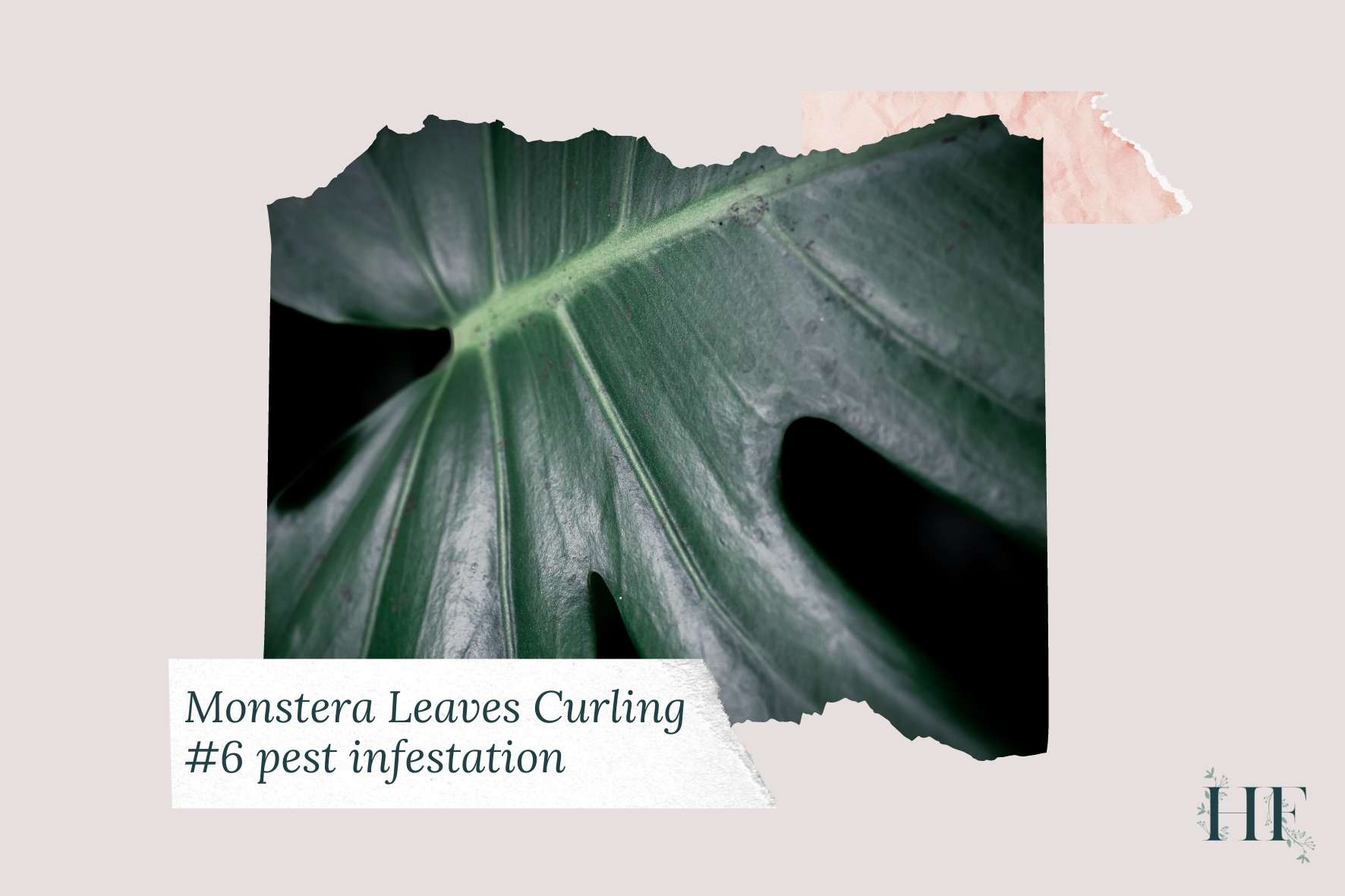
6) Pest Infestation
A bad pest infestation will cause the plant to lose considerable water and nutrients through the injuries on its leaves.
The most common sap-sucking insects that you may encounter on your Monstera are spider mites, aphids, mealybugs, and thrips. They feed on nutrient-rich sap leaves, causing them to curl.
How to Check If a Pest Infestation Is the Cause
- Inspect your Monstera leaves for any signs of insects, which include: cottony webbing, sticky residue (honeydew), insect droppings or actual insects.
- You may notice changes in leaf colour and texture such as small yellow spots or speckled leaves.
How to Fix Pest Infestation
First of all, isolate your Monstera plant from other houseplants to avoid the pest from spreading.
Then, you need to kill these insects as soon as possible or your plant will eventually die. To get rid of the pest infestation, wash your Monstera plant leaves and stems using a soap and water solution to get rid of pests.
Insecticidal Soap Recipe: Dilute a tablespoon of unscented dish soap (I use this one, which is free of harsh ingredients) diluted in a gallon of water (4.5L). Then dip a soft cloth in the solution and clean off the infestation. You can also spray the solution using a spray bottle.
Alternatively, neem oil also works well to get rid of pests.
Neem Oil Fungicide Recipe: To use neem oil as a fungicide, mix a teaspoon of neem oil with a quarter of a gallon (1 litre) of water. Then add a couple of drops of dish soap to emulsify the mixture, and mix well. After, you can apply this mixture with a spray bottle or wipe the affected areas using a soft cloth.
You might need to repeat either of these treatments until you get rid of the pest infestation completely.
For more, read 11 Monstera Pests and Diseases Plus How to Get Rid of Them.
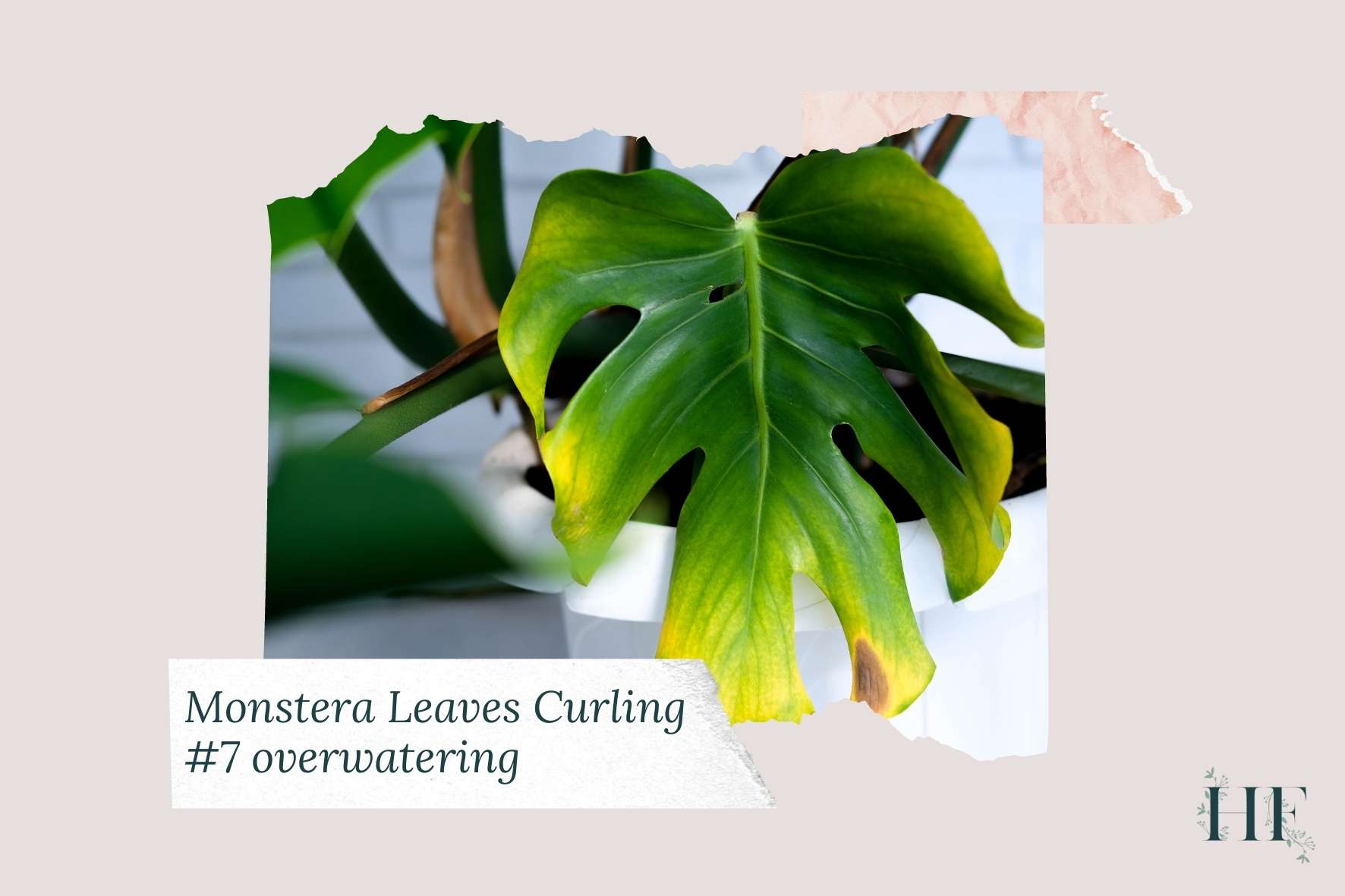
7) Overwatering
If you have been watering your Monstera regularly and still its leaves are curling, it can be an overwatering problem.
When your Monstera is overwatered, the soil is wet, which leads to fungal diseases such as root rot. When the root system is damaged, it will not be able to transport nutrients and water for the rest of the plant, also causing its leaves to curl.
How to Check If Overwatering Is the Cause
To determine if your Monstera is overwatered, you need to check the moisture level of the soil. You can either do the finger test, the stick method or use a moisture meter (the most accurate method to determine how much water is in the soil).
If the soil is wet, less than 2 inches below the surface or reads wet (8-10) on your meter and you haven’t watered for a few days, your Monstera is overwatered.
How to Fix Overwatering
If your Monstera plant is a little overwatered and not showing signs of root rot, simply give it a chance to dry out before watering it.
But, if your Swiss Cheese Plant is suffering from root rot, likely if you are seeing those soft brown spots or areas on the leaf, you will need to repot your Monstera as soon as possible, using a potting mix with better drainage.
Remember that overwatering is due to watering too often (especially during their dormant period). It can also occur due to heavy, poorly drained soil, oversized pots, or lack of drainage. So, you may want to consider its potting mix and type of pot when repotting.
For more, read Monstera Root Rot Signs, Causes and Recovery Tips.
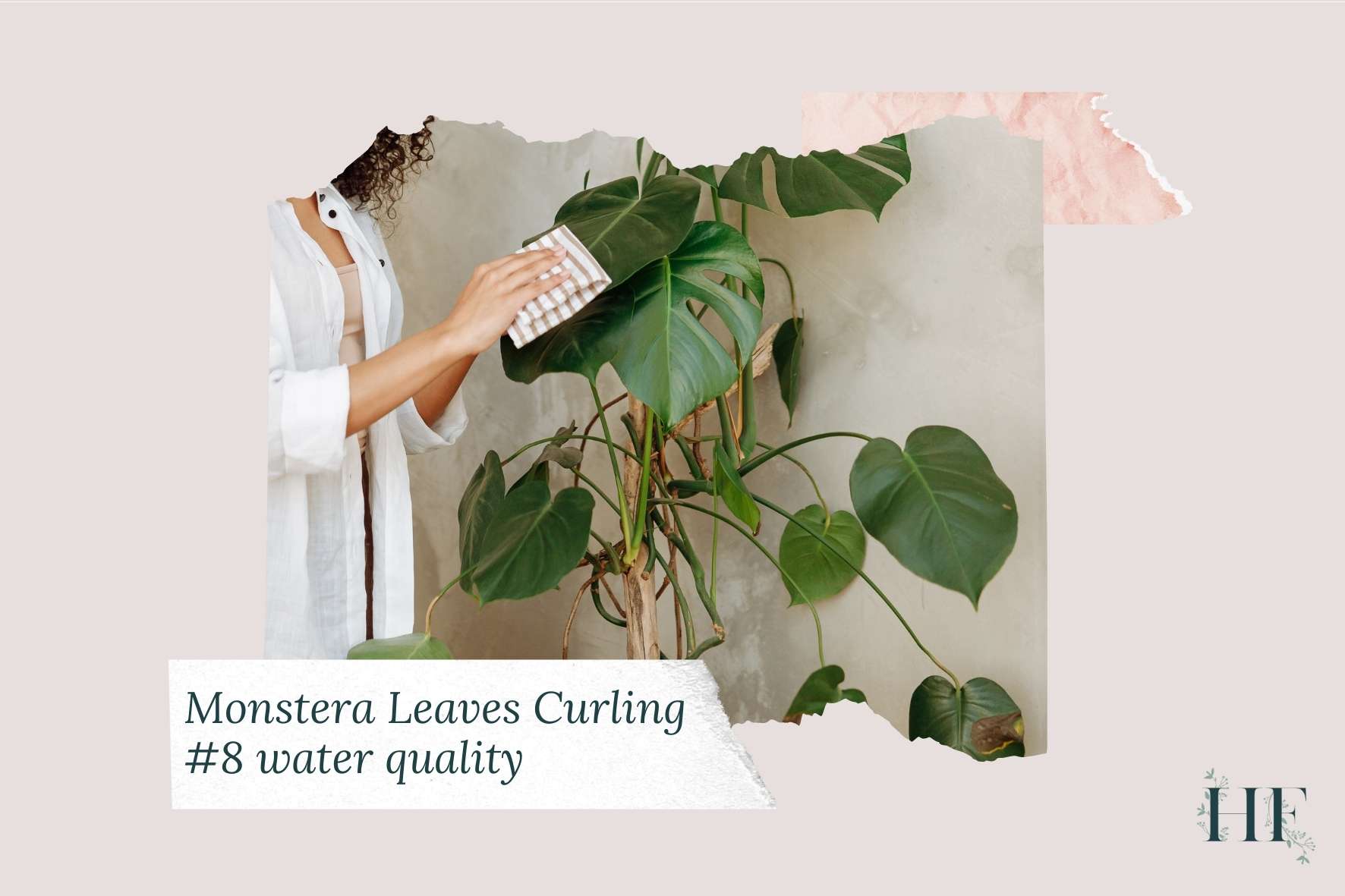
8) Water Quality
Another thing worth looking into is type of water that you are using when watering your Monstera plant.
Tap water can contain chlorine and fluoride (which are added to help stop the spread of germs) that can damage your Monstera causing brown leaf tips on your Monstera (source).
Also, when using tap water extensively, the salt build-up will damage your Monstera’s roots, which affects the intake of water and nutrients. As a result, the defence mechanism is triggered and your Monstera’s leaves will curl.
How to Check If Water Quality Is the Cause
You can test the quality of tap water in your area to make sure there’s no chlorine or fluoride in it. You can use a fluoride test kit which also tells you about chlorine levels, hardness, pH, etc.
How to Fix Water Quality
Ideally, you should be watering your plants with rainwater, instead of using tap water which can contain fluoride or is classified as hard water due to its high contents in limescale.
Rainwater is the best type of water for Monsteras. But, if you do not have access to rainwater, spring water and filtered water are also good options.
Avoid tap water unless you live in an area with high-quality tap water. If you have hard water, the excess buildup of minerals can prevent the plant’s root system from absorbing enough oxygen, water and nutrients.
If you only have access to tap water, leaving it to sit out overnight can allow some of the chlorine to evaporate before you use it.
Finally, if you suspect that there’s root damage, you can trim off the affected parts and repot your Monstera afterwards using a well-draining soil mix.
For more, read A Guide to Monstera Water Needs (How Often and When).
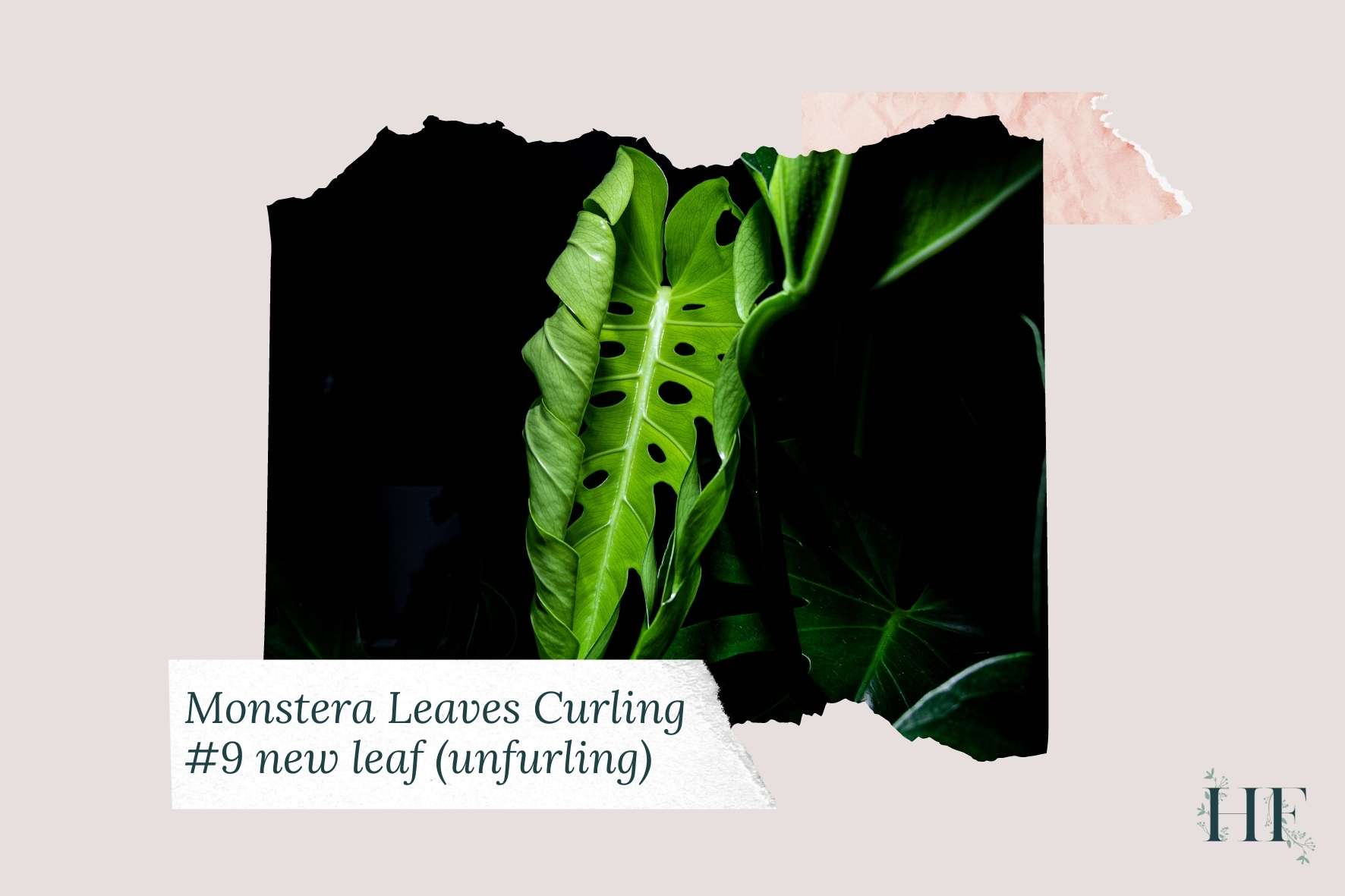
9) New Leaves
Finally, it’s worth mentioning that the tight curling of new leaves in a Monstera is normal before they unfurl. This is not a cause of concern.
New leaves are curled up tight when they first emerge before they fully unfurl. Furled Monstera leaves are very delicate and should never be unfurled by hand. Doing so can cause brown spots or stunted growth.
For more, read Monstera Leaves and Fenestration Stages [Split Tips Included].
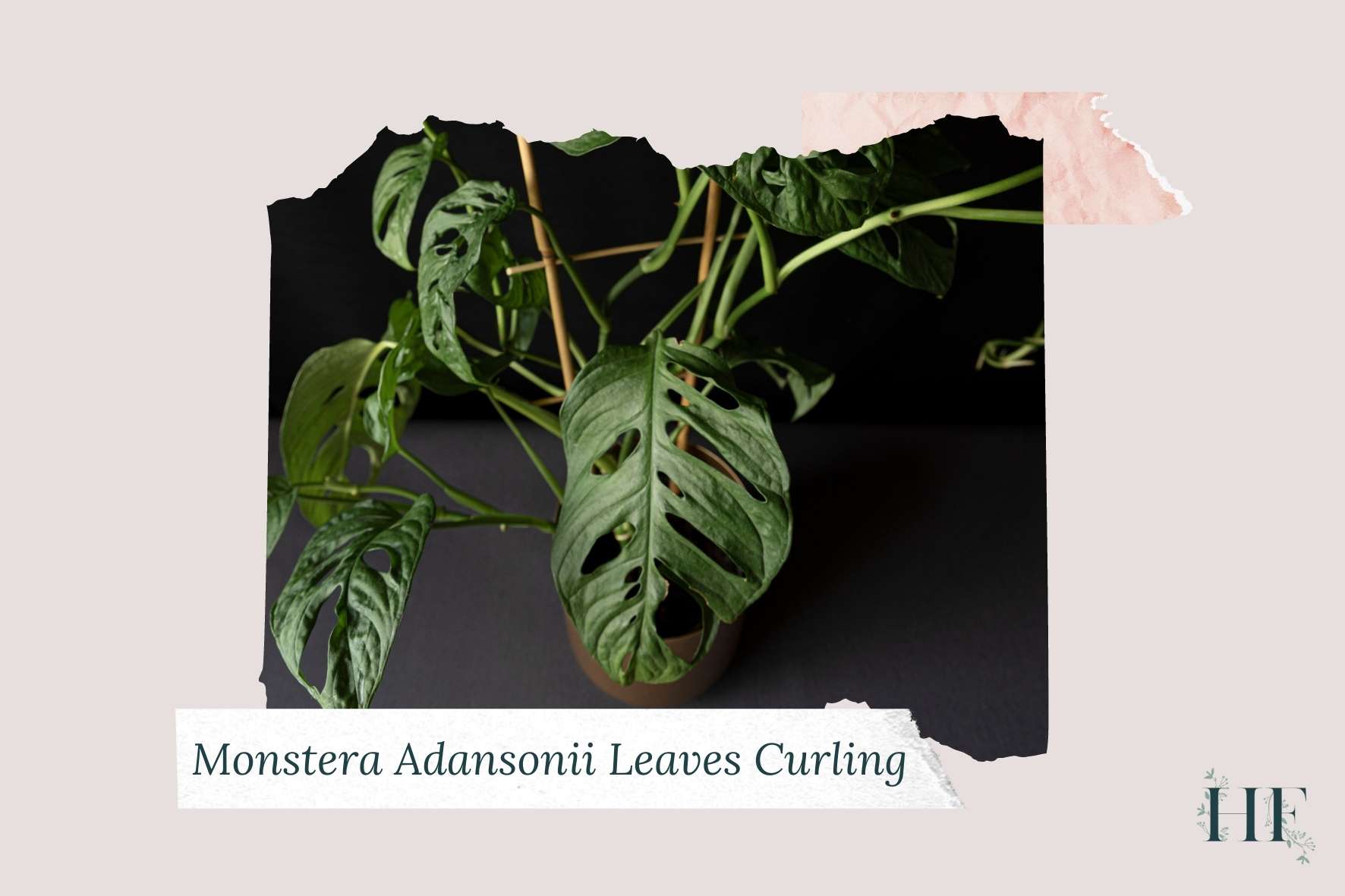
Related Questions
Do Monstera Leaves Uncurl?
Your Monstera leaves can uncurl but it depends on the cause, the extent of the damage and if the issue is addressed in time. Since Monstera leaves curl because of numerous reasons, by managing the cause the leaves have more chances to uncurl.
Those leaves that do uncurl are those that aren’t too adversely affected. However, if the problem has gone on for too long, some leaves may not recover.
Usually, curling caused by mild underwatering, low humidity or rootbound will recover if you act fast.
The minute you notice your Monstera leaves curling down, it’s time to act. Determine the cause and solve it. In mild cases, you will notice a quick change in the plant as it gets better.
On the other hand, if the leaves curl because of insect infestation, they are less likely to uncurl.
How Long Does It Take a Monstera Leaf to Uncurl?
Uncurling can take between 1 and 7 days, depending on the extent of the issue. The only way for this to happen is by determining what is the cause and solving the problem accordingly.
Usually, the longer your plant has been in distress, the longer it will take for your Monstera’s leaves to uncurl. However, if there is too much damage, the leaf might not recover at all.

